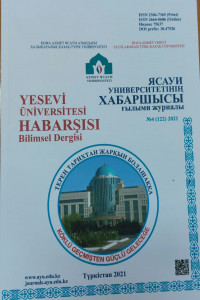Semantic Features of Particles in Turkic Languages
Turkic languages, linguistics, the grammatical category, the modal value, auxiliary words, particle, semantic features, lexical and grammatical meaning
Semantic Features of Particles in Turkic Languages
Turkic languages, linguistics, the grammatical category, the modal value, auxiliary words, particle, semantic features, lexical and grammatical meaning,
___
- 1. Túımebaev J., Saǵıdolda G., Eskeeva M. Túrkі tіlderіnіń salystyrmaly-tarıhı grammatıkasy. (Fonetıka. Morfologııa). – Almaty: Qazyǵurt, 2017. – 324 b.
- 2. Orazov M. Kómekshі sózder. I. – Tashkent, 1997. - 235 b.
- 3. Túımebaev J., Saǵıdolda G. Qazaq jáne túrіk tіlderіnіń salystyrmaly-sıpattamaly grammatıkasy (Fonetıka. Morfologııa). – Almaty: Qazyǵurt, 2016. 324 bet.
- 4.Qazaq grammatıkasy. Fonetıka, sózjasam, morfologııa, sıntaksıs. – Astana, 2002. – 782 b.
- 5. Kyrgyz tılı. – Bıshkek, 1996. - 146 b.
- 6. Házırgı qaraqalpaq ádebı tılınıń grammatıkasy. Sóz jasalyý hám morfologııa. – Nókıs: Bılım, 1994. – 452 b.
- 7. Hısamova F.M. Tatar tele morfologııase. Iýgary ýký ıortlary óchen dáreslek. – Kazan, 2006. - 220 b.
- 8. Abdýrohmonov H., Rafıev A., Shodmonqýlova D. Ýzbek tılınıng amalıı grammatıkası. – Toshkent: Ýqýtıvchı, 1992. - 123 b.
- 9. Türkmen diliniñgrammatikasy. Morfologiўa. – Aşgabat: Ruh, 1999. - 72-87 b.
- 10. Qalybaeva A., Oralbaeva N. Qazіrgі qazaq tіlіnіń morfemalar júıesі. – Almaty, 1986. – 192 b.
- 11. Nurmahanova Á.N. Túrkі tіlderіnіń salystyrmaly grammatıkasy. – Almaty, 1971. – 292 b.
- 12. Davletov S., Kýdaıbergenov S. Azyrky kyrgyz tılı. Morfologııa. – Frýnze, 1980.
- 13. Ýsmanova M.G. Grammatıka bashkırskogo ıazyka dlıa ızýchaıýıh ıazyk kak gosýdarstvennyı. – Ýfa: Kıtap, 2006. – 128 s.
- 14. Һazırqı zaman ýıǵýr tılı. Morfologııa vá sıntaksıs. II. – Almaty: Ǵylym, 1966. – 456 b.
- 15. Hacıeminoğlu N. Türk dilinde edatlar. – İstanbul, 1974. – 336 b.
- 16. Ámіrov R. Jaı sóılem sıntaksısі. – Almaty: Mektep, 1983. – 168 b.
- 17. Noǵaev A. Qazaq tіlіndegі demeýlіk shylaýlardyń qoldanystaǵy maǵynasy men qyzmetі. – Almaty, 2008.
- 18. Korkmaz Z. Türkiye Türkçesi Grameri. – Ankara, 2009. – 1224 b.
- 19. Túımebaev J., Saǵıdolda G. Qazaq jáne tatar tіlderіnіń salystyrmaly-sıpattamaly grammatıkasy. (Fonetıka. Morfologııa). – Almaty: Qazyǵurt, 2017. – 240 b.
- 20. Aıdarov Ǵ., Quryshjanov Á., Tomanov M. Kóne túrkі jazba eskertkіshterіnіń tіlі. – Almaty: Mektep, 1971. – 272 b.
- 21. Túımebaev J., Eskeeva M. Kóne túrkі jazba eskertkіshterі tіlіnіń morfologııalyq júıesі. – Almaty: Qazyǵurt, 2016. – 368 b.
- 22. Aıdarov Ǵ. Kúltegіn eskertkіshі. – Almaty, 1995. - 254 b.
- 23. Ysqaqov A. Qazіrgі qazaq tіlі. – Almaty, 1991. - 147 b.
- Yayın Aralığı: Aylık
- Yayıncı: Hoca Ahmet Yesevi Uluslararası Türk-Kazak Üniversitesi
On the Importance of Physical Culture in the Development of Personality
B.а. AKHMEDOV, A.k. ABİLDAEV, B.k. MUKHAMEDZHANOV
Information about Newspapers and Magazines Published during the Great Patriotic War of 1941–1945
G. BATYRBEKKYZY, G.t. ZHORAYEVA, A.a. BAİZHANOVA
Emotional Intelligence As a Key Competence of a Teache
T.k. BOLEYEV, A.m. AMANBAYEVA, K.в. BOLEYEV
İSLÂM HUKUKU TEMELİNDE KOCANIN TALÂK (BOŞAMA) YETKİSİNİN KANUNEN KISITLANMASI SORUNU
Y. ALPYSBAYEV, F. BESHER, B. SHAYZAN, Zh. RAKHİMGAZİYEV
Knowledge as the Main Capital in Ensuring the Spiritual Rebirth of the Nation
Zh.ı. ISSAYEVA, G.b. DAİRABAEVA
U. RAKHMET, B.b. KALMATAEVA, D.u. BAYSALOV, M. TUYEBAYEV
AUTONOMOUS LEARNING FOR STUDENT TEACHERS OF ENGLISH
Adolescent Suicide and Ways To Prevent It
D.s. ZHARKİNBAYEVA, T.k. BOLEYEV, Sh.a. TULEBAEVA
Virtual Reality and the Problem of Realizing a Person’s Creative Potential
The Meaning of Intertextual Connections in the Poetry of G. Zhaylybay
